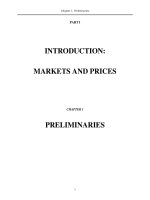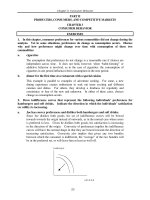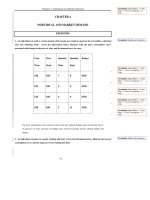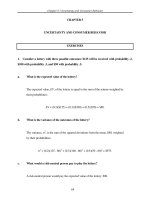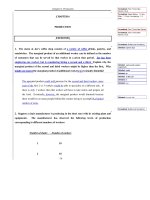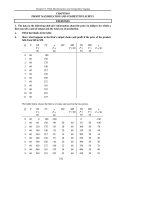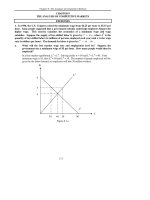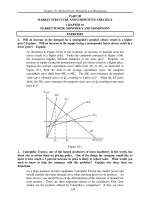Tài liệu Bài tập về Kinh tế vĩ mô bằng tiếng Anh - Chương 6 doc
Bạn đang xem bản rút gọn của tài liệu. Xem và tải ngay bản đầy đủ của tài liệu tại đây (100.1 KB, 13 trang )
Chapter 6: Production
74
CHAPTER 6
PRODUCTION
EXERCISES
1. The menu at Joe’s coffee shop consists of a variety of coffee drinks, pastries, and
sandwiches. The marginal product of an additional worker can be defined as the number
of customers that can be served by that worker in a given time period. Joe has been
employing one worker, but is considering hiring a second and a third. Explain why the
marginal product of the second and third workers might be higher than the first. Why
might you expect the marginal product of additional workers to eventually diminish?
The marginal product could well increase for the second and third workers, since
each of the first 2 or 3 workers would be able to specialize in a different task. If
there is only 1 worker, then that worker will have to take orders and prepare all
the food. Eventually, however, the marginal product would diminish because
there would be too many people behind the counter trying to accomplish a limited
number of tasks.
2. Suppose a chair manufacturer is producing in the short run (with its existing plant and
equipment). The manufacturer has observed the following levels of production
corresponding to different numbers of workers:
Number of chairs Number of workers
1 10
2 18
Formatted: Font: Times New
Roman, 12 pt
Formatted: Space Before: 1.2 line,
After: 1.2 line, Line spacing: 1.5
lines
Formatted: Font: Times New Roman
Formatted: Font: Times New
Roman, 12 pt
Formatted: Bullets and Numbering
Formatted: Bullets and Numbering
Deleted: espresso type
Deleted: and second workers,
respectively
Deleted: would
Deleted: an
Deleted: in this case
Deleted: M
Deleted: may
Deleted: the same task
Chapter 6: Production
75
3 24
4 28
5 30
6 28
7 25
a. Calculate the marginal and average product of labor for this production function.
The average product of labor, AP
L
, is equal to
Q
L
. The marginal product of labor,
MP
L
, is equal to
Δ
Δ
Q
L
, the change in output divided by the change in labor input.
For this production process we have:
L Q
AP
L
MP
L
0 0 __ __
1 10 10 10
2 18 9 8
3 24 8 6
4 28 7 4
5 30 6 2
6 28 4.7 -2
Formatted: Font: Times New Roman
Formatted: Font: Times New
Roman, 12 pt
Formatted: Space Before: 1.2 line,
After: 1.2 line, Line spacing: 1.5
lines
Formatted Table
Formatted: Space Before: 1.2 line,
After: 1.2 line, Line spacing: 1.5
lines
Formatted: Space Before: 1.2 line,
After: 1.2 line, Line spacing: 1.5
lines
Formatted: Space Before: 1.2 line,
After: 1.2 line, Line spacing: 1.5
lines
Formatted: Space Before: 1.2 line,
After: 1.2 line, Line spacing: 1.5
lines
Formatted: Space Before: 1.2 line,
After: 1.2 line, Line spacing: 1.5
lines
Formatted: Space Before: 1.2 line,
After: 1.2 line, Line spacing: 1.5
lines
Deleted: ¶
¶
¶
¶
¶
¶
¶
Chapter 6: Production
76
7 25 3.6 -3
b. Does this production function exhibit diminishing returns to labor? Explain.
This production process exhibits diminishing returns to labor. The marginal
product of labor, the extra output produced by each additional worker, diminishes
as workers are added, and is actually negative for the sixth and seventh workers.
c. Explain intuitively what might cause the marginal product of labor to become
negative.
Labor’s negative marginal product for
L
> 5 may arise from congestion in the chair
manufacturer’s factory. Since more laborers are using the same, fixed amount of
capital, it is possible that they could get in each other’s way, decreasing efficiency
and the amount of output. Many firms also have to control the quality of output and
the high congestion of labor may produce output that is not of a high enough quality
to be offered for sale, which can contribute to a negative marginal product.
3. Fill in the gaps in the table below.
Quantity of
Variable Input
Total
Output
Marginal Product
of Variable Input
Average Product
of Variable Input
0 0
1 225
2 300
3 300
4 1140
Formatted: Space Before: 1.2 line,
After: 1.2 line, Line spacing: 1.5
lines
Formatted: Space Before: 1.2 line,
After: 1.2 line, Line spacing: 1.5
lines
Formatted: Font: Times New Roman
Formatted: Font: Times New
Roman, 12 pt
Formatted: Space Before: 1.2 line,
After: 1.2 line, Line spacing: 1.5
lines
Formatted Table
Formatted: Space Before: 1.2 line,
After: 1.2 line, Line spacing: 1.5
lines
Formatted: Space Before: 1.2 line,
After: 1.2 line, Line spacing: 1.5
lines
Formatted: Space Before: 1.2 line,
After: 1.2 line, Line spacing: 1.5
lines
Formatted: Space Before: 1.2 line,
After: 1.2 line, Line spacing: 1.5
lines
Chapter 6: Production
77
5 225
6 225
Quantity of
Variable Input
Total
Output
Marginal Product
of Variable Input
Average Product
of Variable Input
0 0 ___ ___
1 225 225 225
2 600 375 300
3 900 300 300
4 1140 240 285
5 1365 225 273
6 1350 -15 225
4. A political campaign manager has to decide whether to emphasize television
advertisements or letters to potential voters in a reelection campaign. Describe the
production function for campaign votes. How might information about this function (such
as the shape of the isoquants) help the campaign manager to plan strategy?
Formatted: Space Before: 1.2 line,
After: 1.2 line, Line spacing: 1.5
lines
Formatted: Space Before: 1.2 line,
After: 1.2 line, Line spacing: 1.5
lines
Formatted: Space Before: 1.2 line,
After: 1.2 line, Line spacing: 1.5
lines
Formatted: Space Before: 1.2 line,
After: 1.2 line, Line spacing: 1.5
lines
Formatted Table
Formatted: Space Before: 1.2 line,
After: 1.2 line, Line spacing: 1.5
lines
Formatted: Space Before: 1.2 line,
After: 1.2 line, Line spacing: 1.5
lines
Formatted: Space Before: 1.2 line,
After: 1.2 line, Line spacing: 1.5
lines
Formatted: Space Before: 1.2 line,
After: 1.2 line, Line spacing: 1.5
lines
Formatted: Space Before: 1.2 line,
After: 1.2 line, Line spacing: 1.5
lines
Formatted: Space Before: 1.2 line,
After: 1.2 line, Line spacing: 1.5
lines
Formatted: Font: Times New Roman
Formatted: Space Before: 1.2 line,
After: 1.2 line, Line spacing: 1.5
lines
Formatted: Font: Times New
Roman, 12 pt
Deleted: ¶
¶
¶
¶
¶
Chapter 6: Production
78
The output of concern to the campaign manager is the number of votes. The
production function uses two inputs, television advertising and direct mail. The use
of these inputs requires knowledge of the substitution possibilities between them. If
the inputs are perfect substitutes, the resultant isoquants are line segments, and the
campaign manager will use only one input based on the relative prices. If the
inputs are not perfect substitutes, the isoquants will have a convex shape. The
campaign manager will then use a combination of the two inputs.
5. For each of the following examples, draw a representative isoquant. What can you say
about the marginal rate of technical substitution in each case?
a. A firm can hire only full-time employees to produce its output, or it can hire some
combination of full-time and part-time employees. For each full-time worker let go,
the firm must hire an increasing number of temporary employees to maintain the
same level of output.
Place part time workers on the vertical axis and full time workers on the
horizontal axis. The slope of the isoquant measures the number of part time
workers that can be exchanged for a full time worker, while still maintaining
output. When we are at the bottom end of the isoquant we have a lot of full time
workers and few part time workers. As we move up the isoquant and give up full
time workers, we must hire more and more part time workers to replace each full
time worker. The slope increases (in absolute value terms) as we move up the
isoquant. The isoquant is therefore convex and we have diminishing marginal
rate of technical substitution.
b. A firm finds they it can always trade two units of labor for one unit of capital and
still keep output constant.
The marginal rate of technical substitution measures the number of units of labor
that can be exchanged for a unit of capital while still maintaining output. If the
Formatted: Font: Times New Roman
Formatted: Font: Times New
Roman, 12 pt
Deleted: permanent
Deleted: permanent employees and
temporary
Deleted: permanent
Deleted: hours
Deleted: Knowing this information will
help the firm choose the right mix of
permanent and temporary employees.
